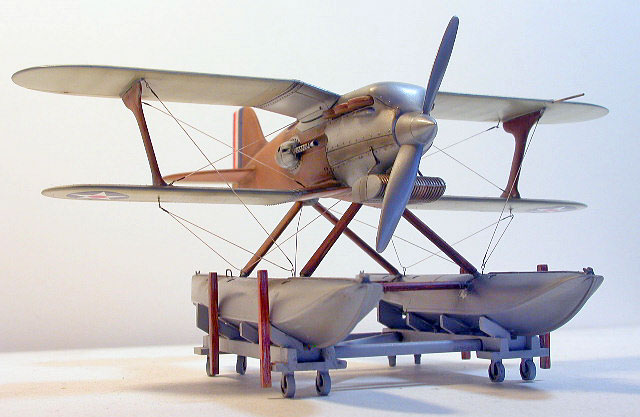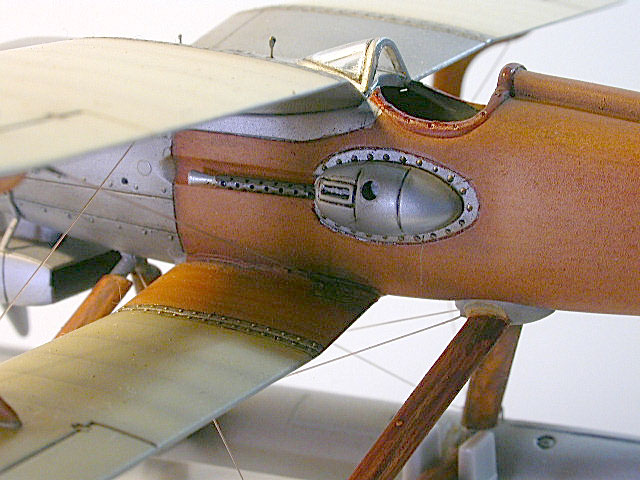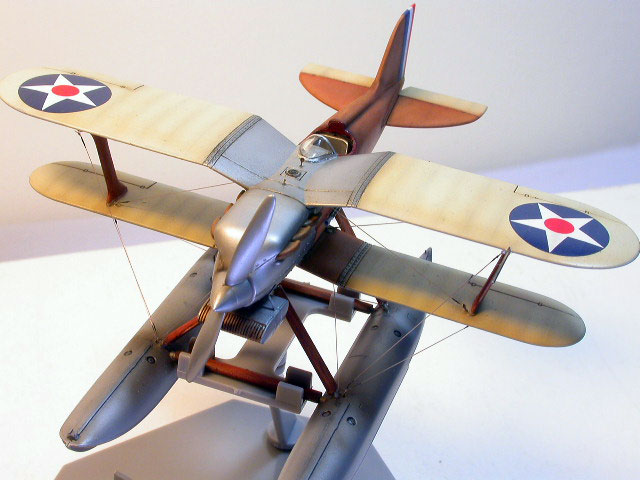|
Fine Molds' 1/72 scale
Curtiss R3c-0
by Roger Fabrocini
|
 |
|
Curtiss R3c-0 Fighter
Seaplane (Unauthorized Modification) |

HyperScale is proudly supported by
Squadron.com
Fine Molds kit #FJ-2
- 1/72 Curtiss R3c-0 Fighter Seaplane (Unauthorized Modification).
The first reaction on seeing this
aircraft inevitably is “what is that?”
To paraphrase the box top:
“The Curtiss R3c is perhaps the finest American air racer of the 1920’s.
In 1925 it won both the Pulitzer Trophy and Schneider Cup and set a
world speed record. Though it now resides in the National Air & Space
Museum there are rumors that this “thoroughbred of the Skies” was used
at one time for illicit activities. Evidence suggests that a R3c,
converted to fighter configuration, was part of an aerial pirate group
that scourged the Adriatic during the summer of 1929. This part of the
R3c’s history is shrouded in mystery.”

In the animated film “PORCO ROSSO”, Japanese filmmaker Hayao Miyazaki
has combined his love of “Golden Age” aircraft and fantasy, to create
hypothetically modified seaplanes. Along with Model manufacturer
FineMolds, Mr. Miyazaki has personally overseen production of some of
the seaplanes from his movie into plastic replicas.
The beauty of these kits is two folds. Not only are they skillfully and
lovingly modified, but they also provide the modeler the freedom to have
fun and experiment with different paint schemes.
I choose to add small amounts of detail
leaving the bulk of my attention to a modified livery for the Curtiss. I
“borrowed” photo-etched pieces from different frets I had to detail the
cockpit. P-47 rudder pedals, spitfire center instrument panel and a
Reheat trim wheel. Eduard colored seatbelts graced the seat and I
mounted a ring and bead gun site between the upper wing.

Rigging was preformed using .002” fishing monofilament line passed
through turnbuckles made of .004” stainless steel surgical wire.
Turnbuckles credit must go to Mr. Jiro Hashimoto, by way of Bucky
Sheftall.
Here was an opportunity to deconstruct
the markings without committing a sin against the religion of
authenticity.
During construction a serendipitous post on Hyperscale’s forum stated
that there are competitions in Japan involving invented markings for
these seaplanes. That was all the inspiration I needed to come up with
my own livery for the R3c-0.
Going into this build I felt that I had two options. Retain the
hypothetical fighter configuration or modify it back to a racer.
Choosing the former sent me researching possible Army Air Corp schemes,
but none were to my liking. During research I learned that the prototype
R3c-2 had a laminated wood fuselage which got me thinking along the
lines of stripping the trophy winning R3c-2 down as if it had just been
modified to a fighter. So be it, wood fuselage and interplane struts,
aluminum floats and engine cowling, clear doped wings.

Nothing new here in way of application, just regurgitating techniques
learned and used by others. Alclad II dull aluminum for the cowling and
floats. Wood replicated with artist oils manipulated over a base of
Floquil Lacquer foundation (wood color). the Clear dope linen was
reproduced with the technique of pre/post shading using various shades
in the Vallejo/Andrea acrylic ranges.
To add some color, i choose to use
cockades and rudder stripes even though they probably would not have
been added until after the aircraft had been painted.
A personal thanks to Mr. Hayao Miyazaki
for starting me on a quest to model more Schneider Trophy seaplanes and
for providing a pleasant diversion from my usual obsessive-compulsive
pursuit of authenticity.
Any praise for this project should be loaded into a shotgun and unloaded
at all HyperScale contributors, thank you all.
Click the
thumbnails below to view larger images:
Model, Images and Text Copyright © 2004
by Roger Fabrocini
Page Created 22 November, 2004
Last Updated
15 December, 2004
Back to
HyperScale Main Page |
Home
| What's New |
Features |
Gallery |
Reviews |
Reference |
Forum |
Search